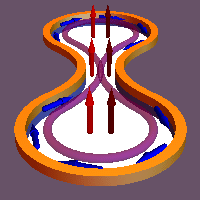Inductive ring trap paper in Nature Communications
Dr Aidan Arnold
In a paper published in Nature Communications, physicists at the Universities of Sussex and Dr Aidan Arnold of Strathclyde show a way to make a new type of flexibly designed microscopic trap for atoms. Trapped atoms are the workhorse for many proposed quantum technology devices. Those devices work better on a small scale, which is more natural for quantum effects. But ultra-small devices can be problematic because of complex fabrication, and unwanted interactions with nearby surfaces (on the micron scale). The new microwave ring trap design will enable exquisite control of cold quantum gases, which can then be utilised with ultimate accuracy in a wide variety of measurement devices. Guiding the atoms enables much longer observation times than in free fall, with correspondingly better results. This latest research builds on over a decade of internationally leading work on ultracold atom ring traps in the Strathclyde EQOP group, and will enable new levels of ring smoothness along with the scalability of chip-based technology. The work extends a paper from earlier this year on radio-frequency dressed theory into the microwave regime.
Universities of Sussex and Dr Aidan Arnold of Strathclyde show a way to make a new type of flexibly designed microscopic trap for atoms. Trapped atoms are the workhorse for many proposed quantum technology devices. Those devices work better on a small scale, which is more natural for quantum effects. But ultra-small devices can be problematic because of complex fabrication, and unwanted interactions with nearby surfaces (on the micron scale). The new microwave ring trap design will enable exquisite control of cold quantum gases, which can then be utilised with ultimate accuracy in a wide variety of measurement devices. Guiding the atoms enables much longer observation times than in free fall, with correspondingly better results. This latest research builds on over a decade of internationally leading work on ultracold atom ring traps in the Strathclyde EQOP group, and will enable new levels of ring smoothness along with the scalability of chip-based technology. The work extends a paper from earlier this year on radio-frequency dressed theory into the microwave regime.
27th November 2014